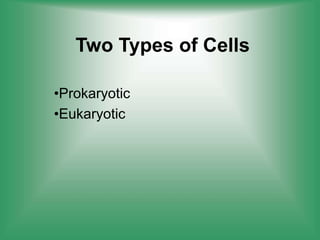Lecture 2
- 2. Cell Theory • All living things are made up of cells. • Cells are the smallest working units of all living things. • All cells come from preexisting cells through cell division.
- 3. Definition of Cell A cell is the smallest unit that is capable of performing life functions.
- 4. Cell Classified to function 1. Muscle cell 2. Nerve cell 3. Epithelial cell 4. Connective tissue cell
- 5. Examples of Cells Amoeba Proteus Plant Stem Red Blood Cell Nerve Cell Bacteria
- 6. Two Types of Cells •Prokaryotic •Eukaryotic
- 7. Prokaryotic • Do not have structures surrounded by membranes • Few internal structures • One-celled organisms, Bacteria
- 8. Eukaryotic • Contain organelles (little organs) surrounded by membranes • Most living organisms Plant Animal
- 10. • Cells are surrounded by cell membrane • The interior of the cell is divided: 1. Nucleus 2. Cytoplasm The Cytoplasm contains two components 1. Cell organelles 2. Cytosol
- 11. Cell Parts Surrounding the Cell
- 12. Cell Membrane Function of cell membrane 1. Regulate the passage of substance into and out of cell and between cell organelles and cytosol. 2. Link adjacent cells together 3. Detect chemical messengers arriving at the cell surface
- 13. The Cell Membrane Structure
- 14. Overview • Cell membrane separates living cell from nonliving surroundings – thin barrier = 8nm thick • Made of phospholipids, proteins & other macromolecules
- 15. Phospholipids Fatty acid Phosphate • Fatty acid tails – hydrophobic • Phosphate group head – hydrophilic • Arranged as a bilayer
- 17. More than lipids… • In 1972, S.J. Singer & G. Nicolson proposed that membrane proteins are inserted into the phospholipid bilayer • Two types of membrane protein 1. Integral membrane 2. Peripheral membrane
- 18. Membrane is a collage of proteins & other molecules embedded in the fluid matrix of the lipid bilayer Extracellular fluid Cholesterol Cytoplasm Glycolipid Transmembrane proteins Filaments of cytoskeleton Peripheral protein Glycoprotein Phospholipids
- 19. Membrane Proteins • Proteins determine membrane’s specific functions – cell membrane & organelle membranes each have unique collections of proteins • Membrane proteins: – peripheral proteins • loosely bound to surface of membrane – integral proteins • penetrate lipid bilayer, usually across whole membrane • transmembrane protein
- 20. Proteins domains anchor molecule • Within membrane – nonpolar amino acids • hydrophobic • anchors protein into membrane • On outer surfaces of membrane – polar amino acids • hydrophilic • extend into extracellular fluid & into cytosol Polar areas of protein Nonpolar areas of protein
- 21. Many Functions of Membrane Proteins Outside Plasma membrane Inside Transporter Cell surface receptor Enzyme activity Cell surface identity marker Attachment to the cytoskeleton Cell adhesion
- 22. Membrane carbohydrates • Play a key role in cell-cell recognition – ability of a cell to distinguish one cell from another – important in organ & tissue development
- 23. Membrane Junctions • Some cell not anchored to other cells but suspend in the fluid. • Most cells are packaged into tissues and are not free to move. • Many cells physically joined by specialized types: 1. Desmosomes 2. Tight junctions 3. Gap junctions
- 24. Inside the Cell
- 25. Nucleus • Almost all cells contain a single nucleus. • Directs cell activities • Separated from cytoplasm by nuclear membrane • Function-Stores and transmits genetic information in the form of DNA. Genetic information passes from the nucleus to the cytoplasm
- 26. Nuclear Membrane • Surrounds nucleus • Made of two layers Nuclear envelope Nuclear pores • Openings allow material to enter and leave nucleus http://library.thinkquest.org/12413/structures.html
- 27. Chromosomes • In nucleus • Made of DNA • Contain instructions for traits & characteristics http://library.thinkquest.org/12413/structures.html
- 28. Nucleolus • Inside nucleus • Contains RNA to build proteins http://library.thinkquest.org/12413/structures.html
- 29. Endoplasmic Reticulum • Moves materials around in cell • Smooth type (Agranular): lacks ribosomes. Site of lipid molecule synthesized • Rough type (Granular): ribosomes embedded in surface. Packaging of proteins to be secreted or distributed. http://library.thinkquest.org/12413/structures.html
- 30. Ribosomes • Composed of proteins and several RNA molecules • Proteins factories of the cell • Either bound to the organelle or found free in the cytoplasm http://library.thinkquest.org/12413/structures.html
- 31. Golgi Apparatus • Most cells have single Golgi apparatus. • Protein 'packaging plant' • Move materials within the cell • Move materials out of the cell http://library.thinkquest.org/12413/structures.html
- 32. Lysosome • Spherical or oval • Typical cell may contain several hundreds • Digestive enzyme for proteins, fats, and carbohydrates • Transports undigested material to cell membrane for removal • Cell breaks down if lysosome explodes http://library.thinkquest.org/12413/structures.html
- 33. Mitochondria • Spherical rode like structure • Produces energy through chemical reactions – breaking down fats & carbohydrates • Controls level of water and other materials in cell • Recycles and decomposes proteins, fats, and carbohydrates http://library.thinkquest.org/12413/structures.html
Editor's Notes
- #19: The carbohydrates are not inserted into the membrane -- they are too hydrophilic for that. They are attached to embedded proteins -- glycoproteins.
- #22: Signal transduction - transmitting a signal from outside the cell to the cell nucleus, like receiving a hormone which triggers a receptor on the inside of the cell that then signals to the nucleus that a protein must be made.
- #23: The four human blood groups (A, B, AB, and O) differ in the external carbohydrates on red blood cells.

































